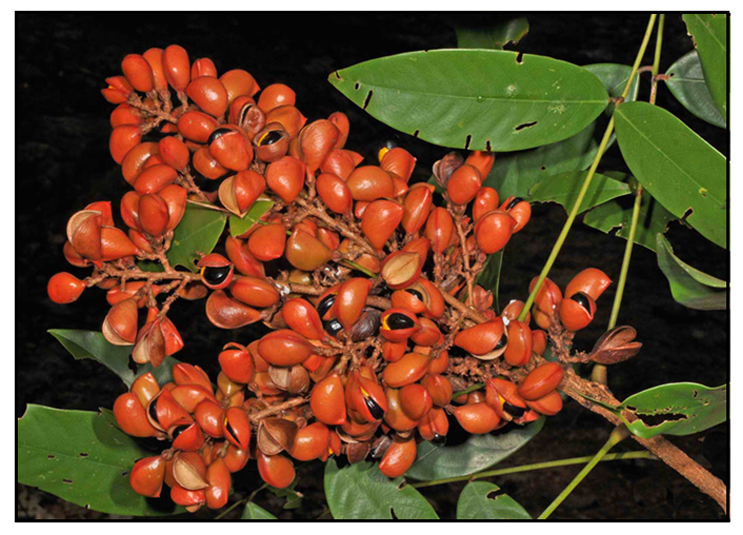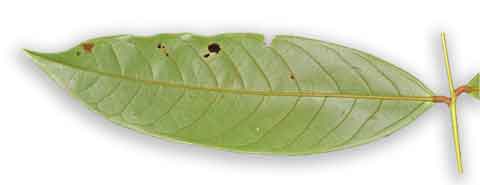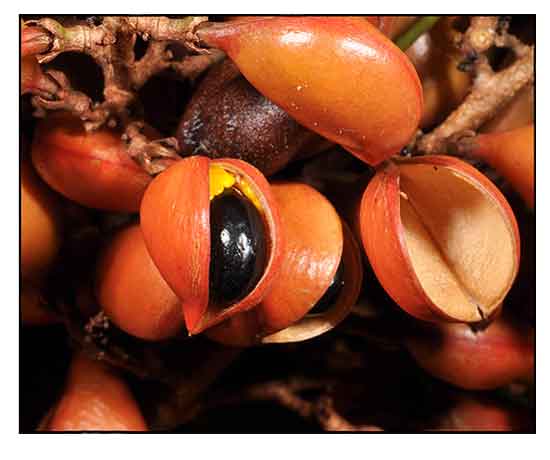
Family • Connaraceae
Sandalino
Connarus semidecandrus Jack
POLIPOG / KAMOT
| Scientific names | Common names |
| Connarus amplifolius Pierre | Kamot (Pamp.) |
| Connarus asiaticus Wiilld. | Polipog (Bis.) |
| Connarus balsahanensis Elmer | Sandalino (Tag.) |
| Connarus borneensis Merr. | |
| Connarus ellipticus G.Schellenb. | |
| Connarus floribundus Wall. ex Hook. f. | |
| Connarus furfuraceus Blume | |
| Connarus gaudichaudii (DC.) Planch. | |
| Connarus gibbosus Wall. ex Hook.f. | |
| Connarus gracilis Bakh.f. | |
| Connarus griffithii Hook.f. | |
| Connarus jackianus G.Schelllenb. | |
| Connarus mekongensis Pierre | |
| Connarus moluccanus Zipp. ex Blume | |
| Connarus mutabilis Blume | |
| Connarus neurocalyx Planch. | |
| Connarus nigropunctua Gagnep. | |
| Connarus obtusifolius Planch. | |
| Connarus pinnatus Lam. | |
| Connarus pyrrhocarpus Miq. | |
| Connarus quocensis Pierre | |
| Connarus semidecandrus Jack | |
| Connarus semidecandrus var. gaudichaudii (DC.) Fosberg | |
| Connarus wallichii Planch. | |
| Omphalobium gaudichaudii DC. | |
| Omphalobium indicum Gaertn. | |
| Omphalobium pinnatum DC. | |
| Connarus neurocalyx Planch. is a synonym of Connarus semidecandrus Jack. | |
| Connarus semidecandrus Jack is an accepted species. KEW: Plants of the World Online | |
| Other vernacular names |
| CAMBODIAN: Am pous, Loum puos, Loum pouh. |
| INDONESIAN: Akar kalat, Simbo krah, Kunit wawakas imbolay, Akar sariawan. |
| LAOTIAN: Houn hai, 'Sop 'sep. |
| MALAY: Akar kuaya, Akar tanga burong, Akar tukor nyamok, Akar tupai tupai, Akar membur. |
| THAI: Thopthaep khruea, Torptaep kreua, Khaang daeng, Maak song. |
| VIETNAMESE: Dây lốp bốp. |
Updated August 2023 / September 2018 / May 2015
![]()
 |
PHOTOS / ILLUSTRATIONS |
| IMAGE SOURCE: Photo: Connarus cf. semidecandrus / infructescence / Copyright © 2014 by P.B. Pelser & J.F. Barcelona (contact: pieter.pelser@canterbury.ac.nz) [ref. DOL89331] / Non-Commercial Use / Phytoimages.siu.edu |
| IMAGE SOURCE: Photo: Connarus semidecandrus / Fruits / Copyright © 2014 by P B Pelser & J F Barcelona (contact: pieter.pelser@canterbury.ac.nz) [ref. DOL89259] / Non-Commercial Use / Image modified / click on link or image to go to source page / Phytoimages.siu.edu |
| IMAGE SOURCE: Photo: Connarus semidecandrus / Abaxial view of leaflet / Copyright © 2014 by P B Pelser & J F Barcelona (contact: pieter.pelser@canterbury.ac.nz) [ref. DOL89280] / Non-Commercial Use / Image modified / click on link or image to go to source page / Phytoimages.siu.edu |
| Additional
Sources and Suggested Readings (1) Connarus semidecandrus Jack / Synonyms / Kew: Plants of the World Online (2) Medicinal Plants in Tropical Rain Forest from Hua Khao Subdistrict, Singha Nakhon District, Songkhla Province, Thailand / Oratai Neamsuvan, Narumon Sengnon, Umad Haddee, Wittawat Mard-E and Warunyu Sae-Tang / American-Eurasian Journal of Sustainable Agriculture (3) Survey of Ethno-medicinal Climbing plants in Andaman and Nicobar Islands, India / Asutosh Ghosh / INTERNATIONAL JOURNAL OF PHARMACY & LIFE SCIENCES, 5(7), July 2014: pp 3671-367 (4) Medicinal Plants Used in the Loengnoktha District / Thai Journal of Phytopharmacy Vol. 9(2) Dec. 2002 (5) Antipyretic activity of Connarus semidecandrus extract in rats / Wantana Reanmongkol, Sanan Subhadhirasakul, Kritawan Muneemonai, Kaesorn Nathong, Gomol Rangkla, Hiromitsu Takayama, / Songklanakarin J Sci Technol 2000, 22(2): pp 191-198 (6) Medicinal plants of the asia pacific - drugs for the future - c. wiart (world, 2006) ww / Feb 10, 2014 (7) Phytochemical screening, total phenolic content and free radical scavenging activity of Bruguiera sexangula and Connarus semidecandrus extracts in Kung Krabaen Bay / Sasipawan Machana, Boonyadist Vongsak, E. Saifha, Bunlung Nuangsaeng / Planta Medica, Nov 2015; 81(16) / DOI: 10.1055/s-0035-1565727 (8) Survey of Ethno-medicinal Climbing plants in Andaman and Nicobar Islands, India / Asutosh Ghosh / INTERNATIONAL JOURNAL OF PHARMACY & LIFE SCIENCES, July 2014; 5(7): pp 3671-3677 (9) Analysis of antioxidant vitamins in 30 Thai vegetables by high-performance liquid chromatographic method / Bungorn Sripanidkulchai, Sudarat Homhual, Chotima Poeknapo / IJPS, July-December 2005; Vol 1, No 2 (10) Connarus semidecandrus Jack Exerts Anti-Alopecia Effects by Targeting 5α-Reductase Activity and an Intrinsic Apoptotic Pathway / Won Young Jang, Dong Seon Kim, Sang Hee Park, Jongsung Lee et al / Molecules, 2022; 27(13): 4086 / DOI: 10.3390/molecules27134086 (11) Connarus semidecandrus (PROSEA) / Wardah / Pl@ntUse (12) Connarus / Wikipedia (13) PARTIAL CHARACTERIZATION OF CONNARUS SEMIDECANDRUS JACK (POLIPOG) LEAVES, BARKS AND ROOTS / Engr Charito B Viscayno-Mollejon / Global Scientific Journals, 2019; 7(1) / eISSN: 2320-9186 |
• |
DOI: It is not uncommon for links on studies/sources to change. Copying and pasting the information on the search window or using the DOI (if available) will often redirect to the new link page. (Citing and Using a (DOI) Digital Object Identifier) |
| List of Understudied Philippine Medicinal Plants |
• |
 |
• |



 Properties
Properties